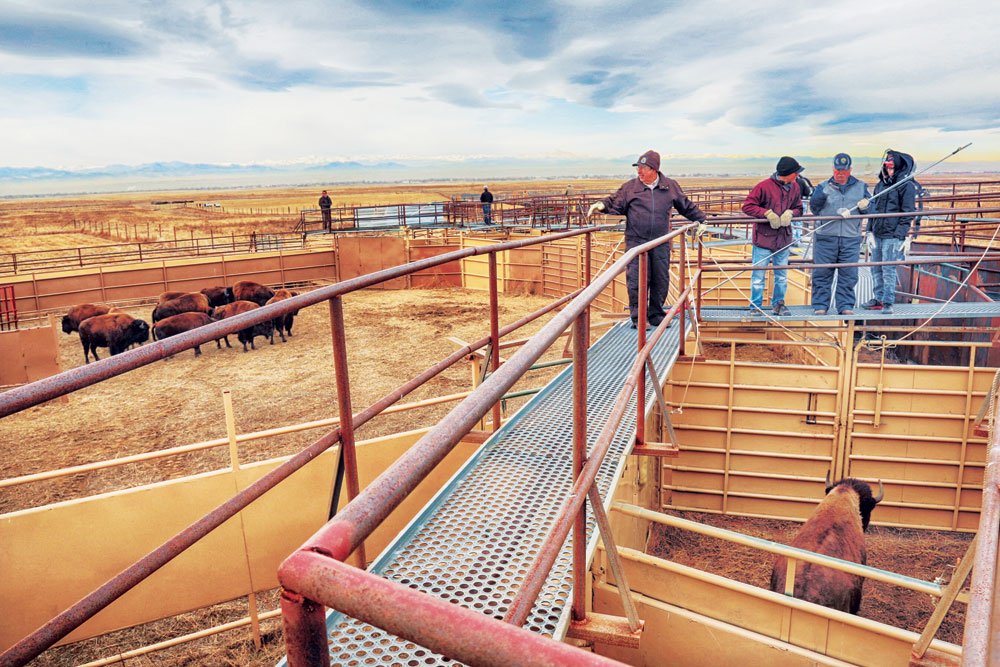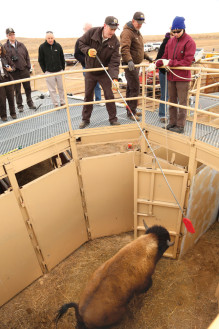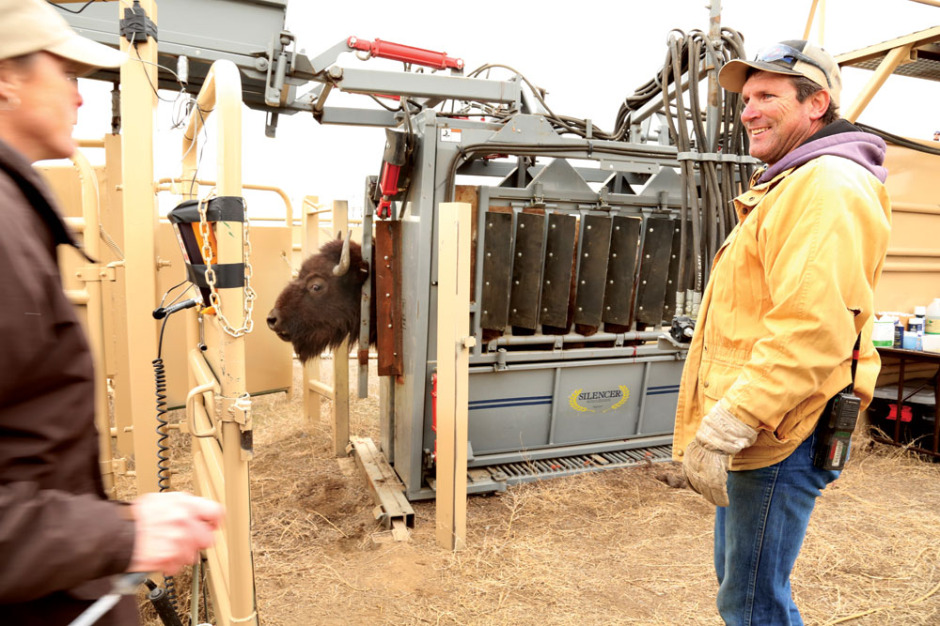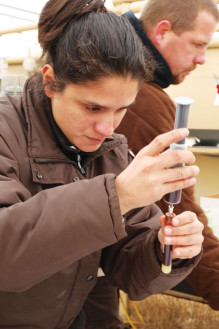
The Rocky Mountain Arsenal NWR uses a corral based on a design by Temple Grandin, an animal science professor who has improved corrals to reduce animals’ stress and fear. Bison move through gated alleys.

Skip Palmer waits on the catwalk for another bison.
“Come on,” veterinarian Lee Jones says to a bison below. She stands on a metal catwalk above the corral and looks at the stubborn bison.
“Why won’t you move?” The bison is not happy and doesn’t like being separated from its herd-mates so it stands in a staring game with Jones.
Like a cat with a toy, Jones uses a long metal pole with a bright red end that makes noise when she shakes it to encourage the bison to move. Eventually it does.
“OK, here she comes,” Jones says to the crew further along the corral. The bison leaps into the next alley, and right at the perfect time, the next worker closes the squeeze chute to compress the bison.
“Yes! You are the best shooter I know!” Jones calls to him, as if cheering on a teammate.
U.S. Fish and Wildlife Service employees gather every year at the Rocky Mountain Arsenal National Wildlife Refuge (NWR) in northeast Denver for the Bison Roundup, a major event to manage the bison population. Workers check bison health, survey herd size and monitor genetic diversity.
NWR is home to 80 bison, including 14 calves born this year. They roam 2,370 acres of pasture, which will eventually be increased to 12,000 acres.

David Lucas, acting refuge manager, uses a long pole with a bright red end that makes noise when he shakes it, to encourage the bison to move into the next alley.
Bison used to roam the entire U.S. from Canada to Mexico, but unrestricted hunting by white settlers dropped the population to near extinction. By 1883, there were fewer than 3,000 bison. In 1894, Congress enacted a law that banned hunting in Yellowstone National Park and kicked off a conservation movement.
Ever since, bison have slowly been repopulating. In 2008, the Department of Interior developed the Bison Conservation Initiative to manage bison as a metapopulation (one big population as opposed to many smaller groups). Conservation groups, ranchers and wildlife refuges, including the Rocky Mountain Arsenal NWR, work together to manage the species for long-term survival.
To begin the Bison Roundup, workers drive their trucks on the pasture and honk the horns to get bison running and into one area—despite their bulky appearance, bison are very agile and can run up to 35mph.
The animals are brought into a corral based on design recommendations by Temple Grandin, PhD in animal science and professor at Colorado State University. Grandin, who was diagnosed with autism as a child, is an all-star in the veterinary world. She relates her autistic mind to animal thinking and throughout her career has developed corrals to minimize animal stress. The roundup is especially stressful for bison. One by one, they are ushered through gated alleys. Some fight the process more than others, smashing into the gates or stomping their hooves.

As she prepares a blood sample, veterinarian Lee Jones praises the shooter at right for compressing the squeeze chute at the perfect time to restrain the bison.
By the end of the day, there are chipped horns, bloody noses and sometimes even broken limbs.
Bison are weighed and moved into a squeeze chute, a V-shaped device with metal flaps used to restrain livestock to be worked on or for health checks.
Much like people with autism, pressure can be calming to bison. The pressure gives a sense of being held without being overwhelmed, according to Grandin’s research.
Surprisingly, even the feistiest bison calm down and no longer try to escape once compressed inside the squeeze chute.

Mery Casady transfers blood to a sample tube.
A veterinarian takes blood, fat and tail hair samples for genetic testing and to check for disease. If a bison needs a simple health procedure, like treating an abscess, the veterinarian will do it then. To start a health record, calves are given a chip in their neck below the ear the size of a grain of rice that identifies them. Bison are released from the corral as soon as the health check is complete.
Once genetic results come back, the Fish and Wildlife Service determines if certain bison need to be traded with other refuges across the country to mix up the gene pool.
“Basically, we are trying to sustain genetic diversity for the long term—so in order to do that you need to continue to manage your herds for as much genetic diversity as possible,” says Cindy Souders, NWR visitor programs manager.
The “fast, agile creatures continue to be one of the biggest attractions at the refuge,” according to Souders. “We have been successful in conserving this species after there basically weren’t many bison on the prairie. It’s a story of recovery.” Visitors, who are asked to remain in their cars while viewing the bison, can see them along the Arsenal’s Wildlife Drive.
As the pasture grows, the refuge plans to increase the herd size and continue restoring the North American population.



0 Comments